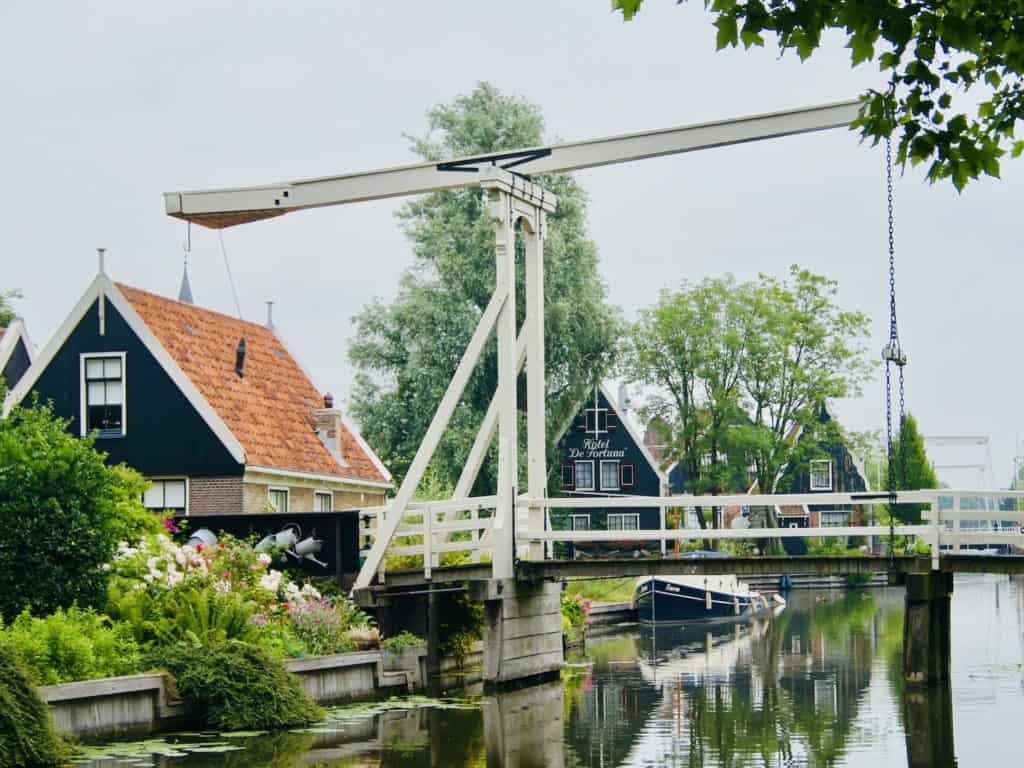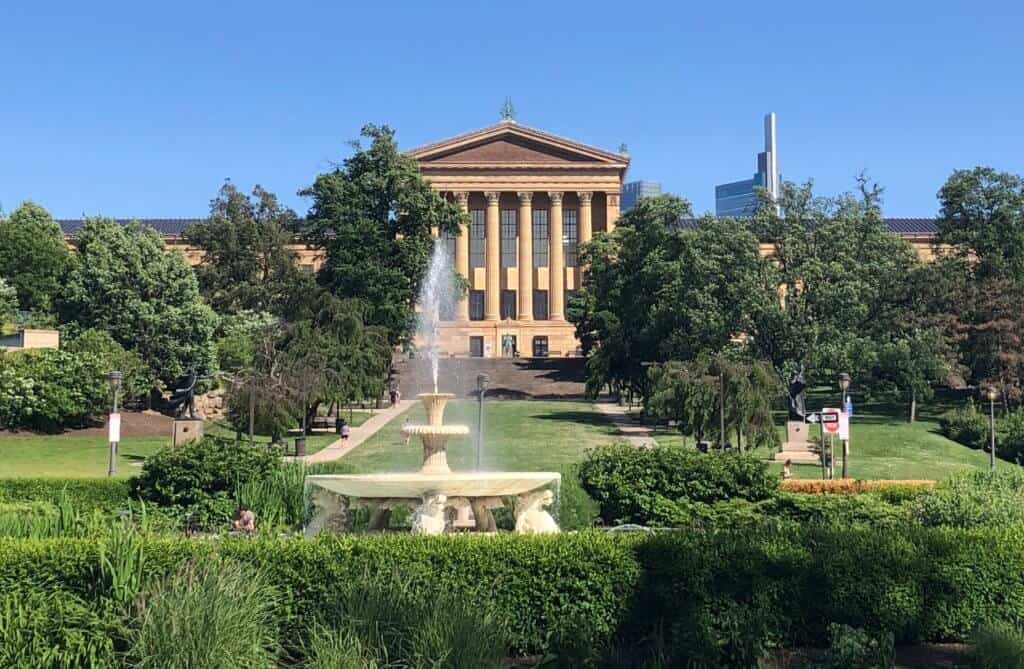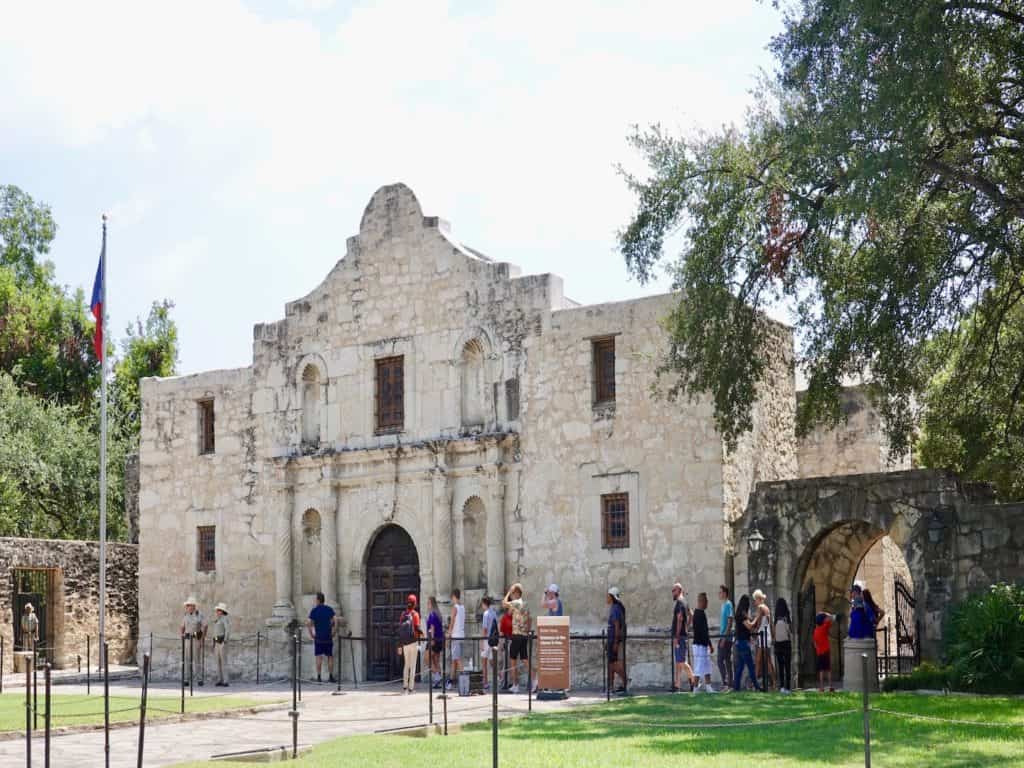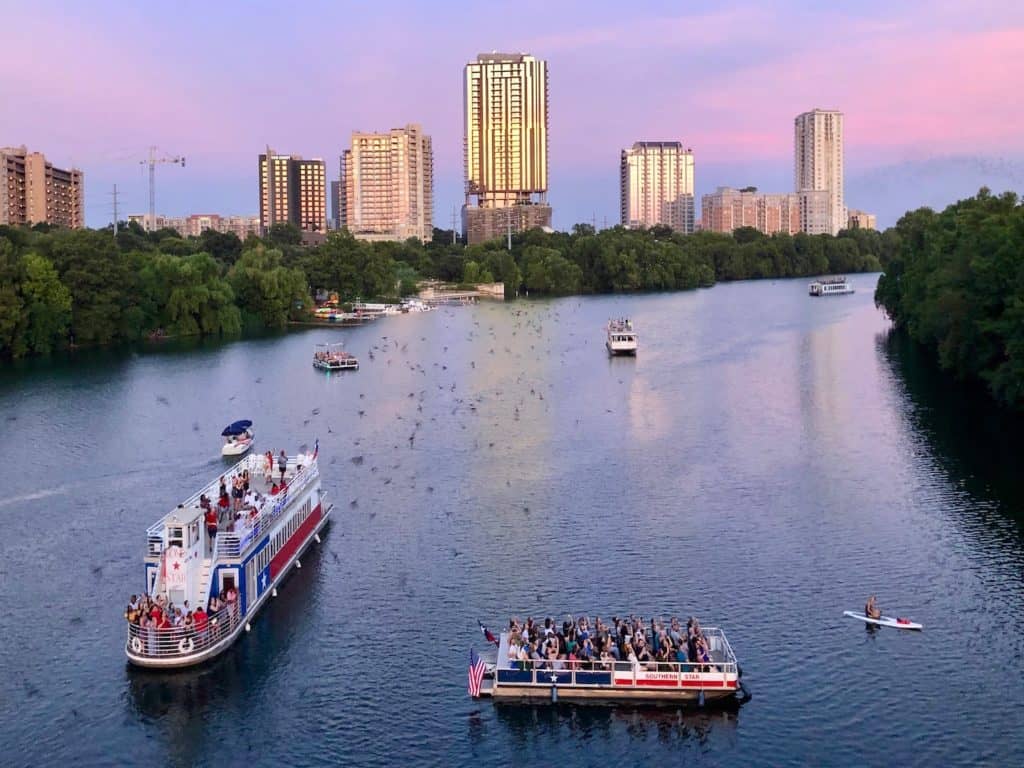Please check the visitor center’s current days and hours of operation before visiting.
Take a step back into colonial history at Washington Crossing State Park in New Jersey. George Washington was on the move in December 1776 (and walked these grounds) and gearing up for what would become a surprise attack on an enemy encampment of Hessian soldiers (paid by the British King) during the American Revolution. Many see the subsequent Battle of Trenton as a turning point in the conflict. Washington and his troops crossed the Delaware River at night and landed on its eastern bank in what is now Washington Crossing State Park in New Jersey. Today Washington Crossing State Park is a good place to learn a bit more about American history and enjoy the park’s trails and views. Washington’s troops were on this side of the river for just a few hours (while waiting for all the soldiers, horses and cannons to be ferried over) before setting off on their march to Trenton, New Jersey — 9 miles south.
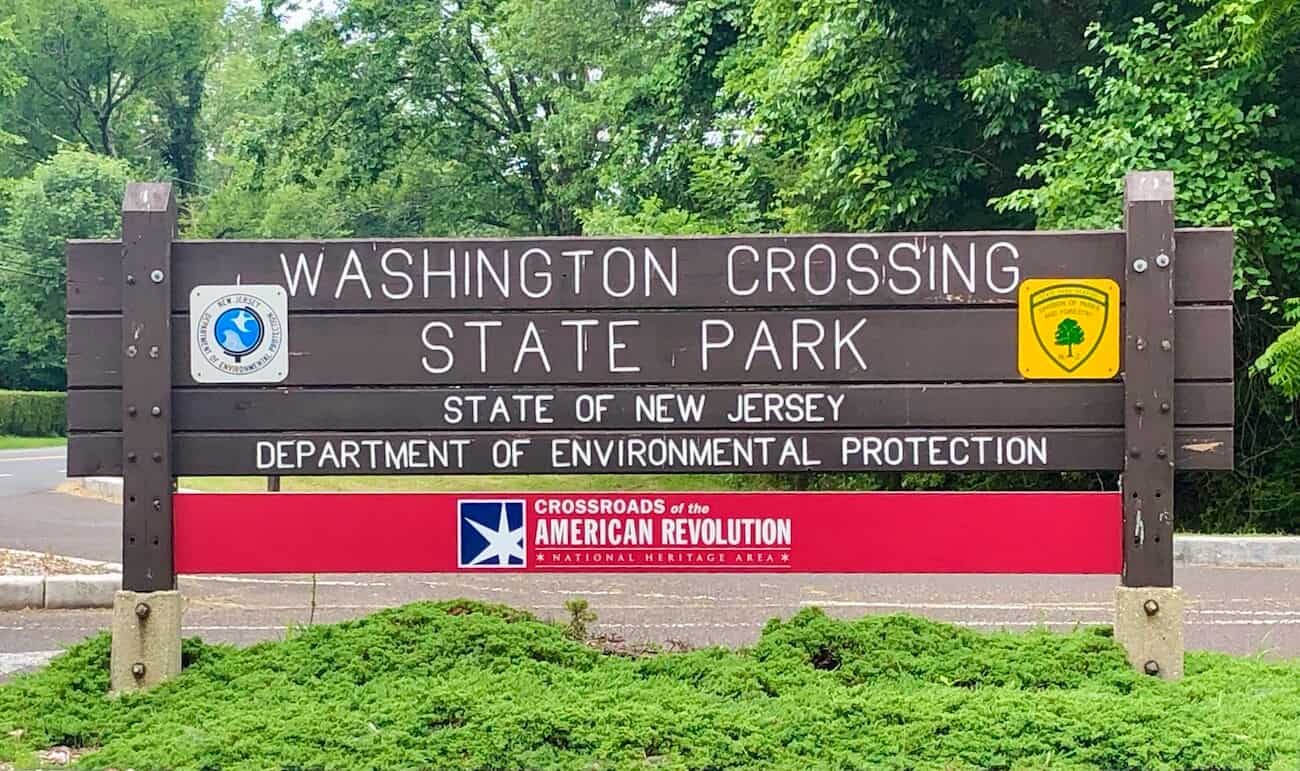
The park’s historic buildings, vistas, and trails make some time here enjoyable. The visitor center hosts events throughout the year; please check in advance of your visit for operating hours by calling them. (I found that calling the visitor center at 609-737-9303 is more accurate than checking the website as you’ll get the most up-to-date information.)
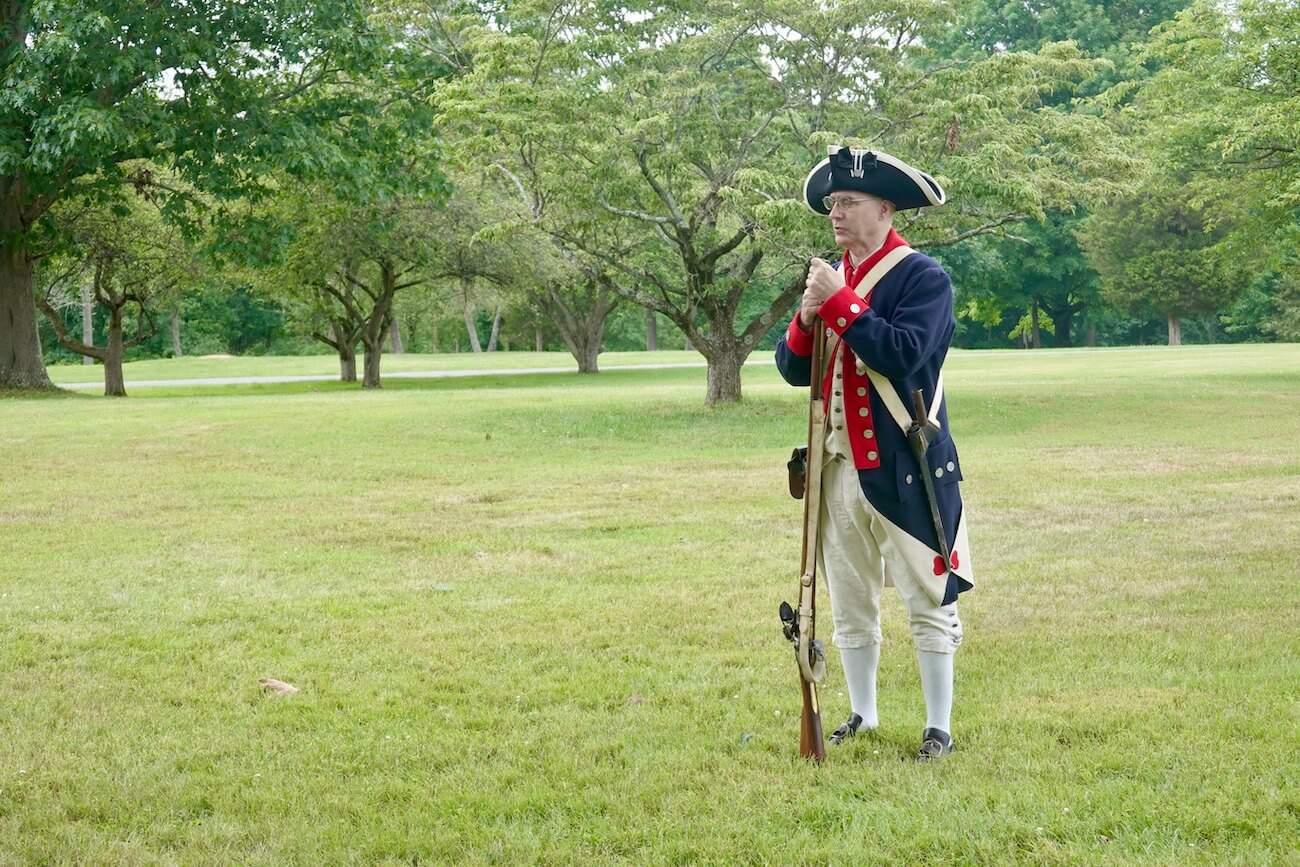
This guide also includes Washington’s Rock (also known as Goat Hill Overlook) which is a few miles north of the park.
To learn more about the three weeks prior to the historic 1776 crossing, visit Washington Crossing Historic Park in PA (take the bridge to cross the river). The two parks on either side of the Delaware River are named so similarly, but they are different state parks in different states.
Admission
If entering through the main gates off Route 546, there could be an entry fee. There’s no fee if entering on foot (or bike) from the western parking lot by Washington Grove and then crossing over the pedestrian bridge to the rest of the park.
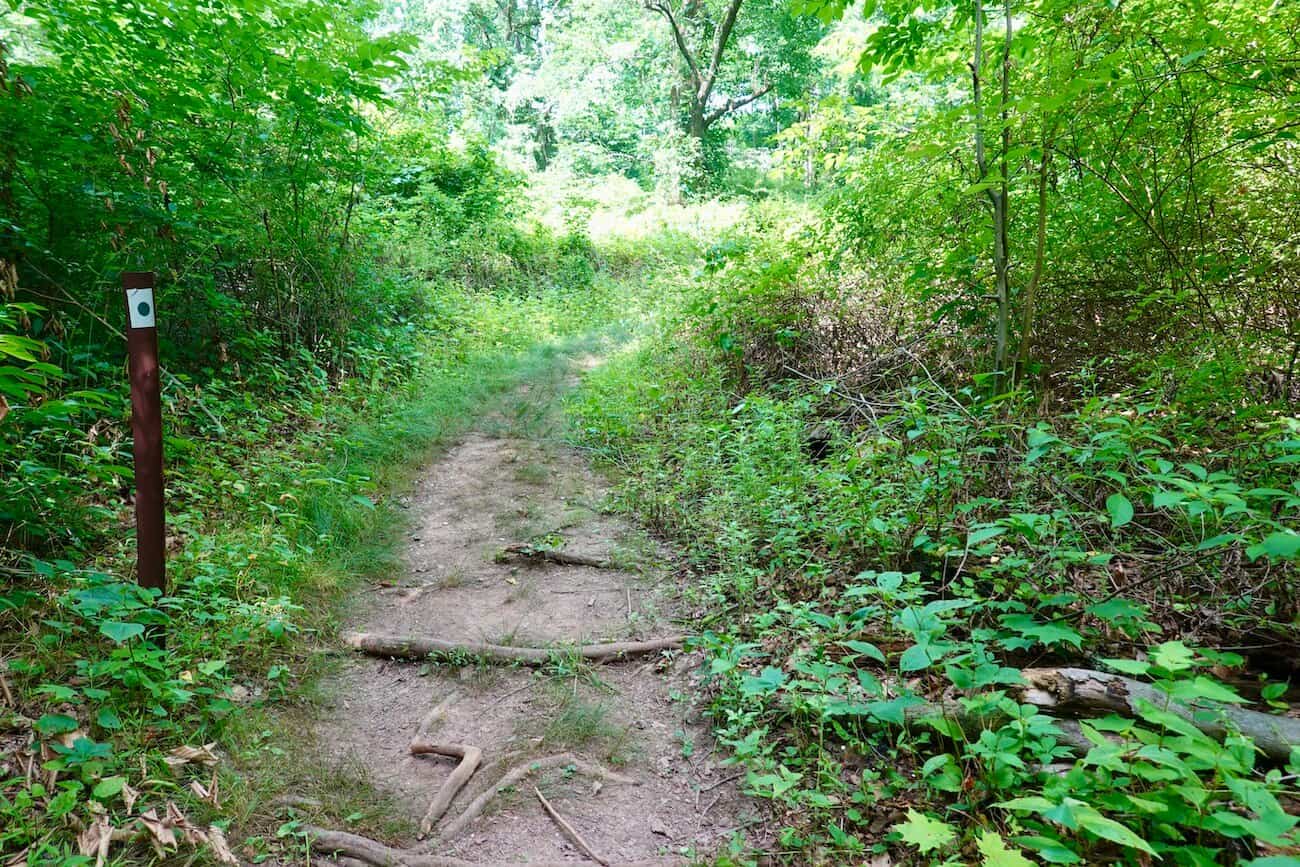
Location
355 Washington Crossing Pennington Rd, Titusville, NJ
Washington Crossing State Park is about 35 miles from Philadelphia, 45 miles from the Lehigh Valley, and 78 miles from NYC.
What You’ll Find at Washington Crossing State Park
There are some historic buildings in the western parking lot along the Delaware River, near Washington Grove. You can start your visit here, visit the historic buildings cross the pedestrian bridge (spanning Route 29), and continue with a hike or bike ride through the rest of the park.
Picnicking is a great option in Washington Grove (by the western parking lot along the river); Sullivan Grove (by the visitor center); or even Green Grove or Knox Grove east of the visitor center.
If starting your trek from the western edge of the park by Washington Grove, you’ll find:
Historic Marker for Washington’s Crossing of the Delaware River
This marker, at the entry to the parking lot, sets the stage for your visit to Washington Crossing State Park on the New Jersey side of the Delaware River.
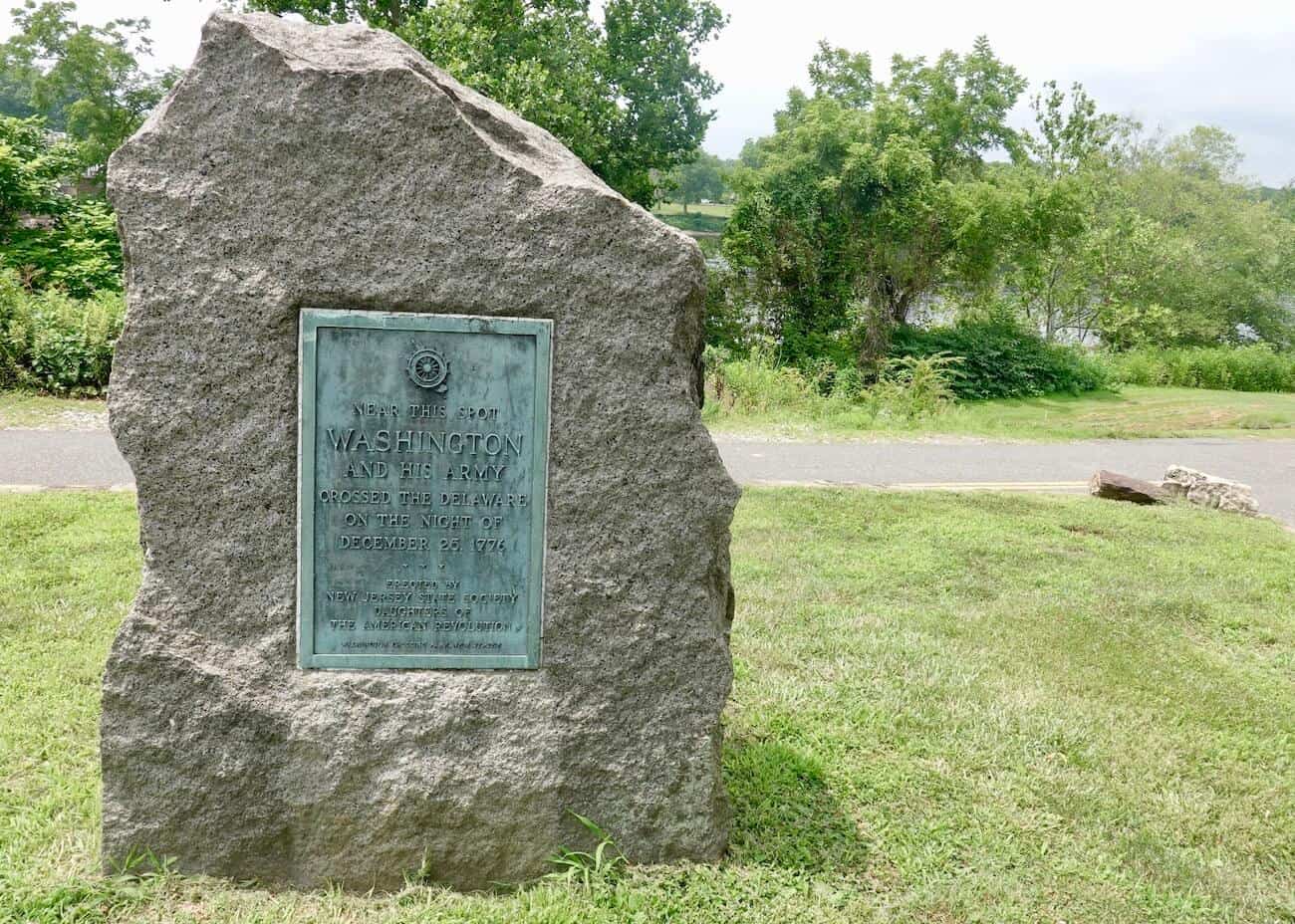
The Nelson House
A tidy little house, this was built in the 19th century — after Washington’s crossing of the Delaware River. There’s a lovely small garden inside the house’s fence to savor while passing by.
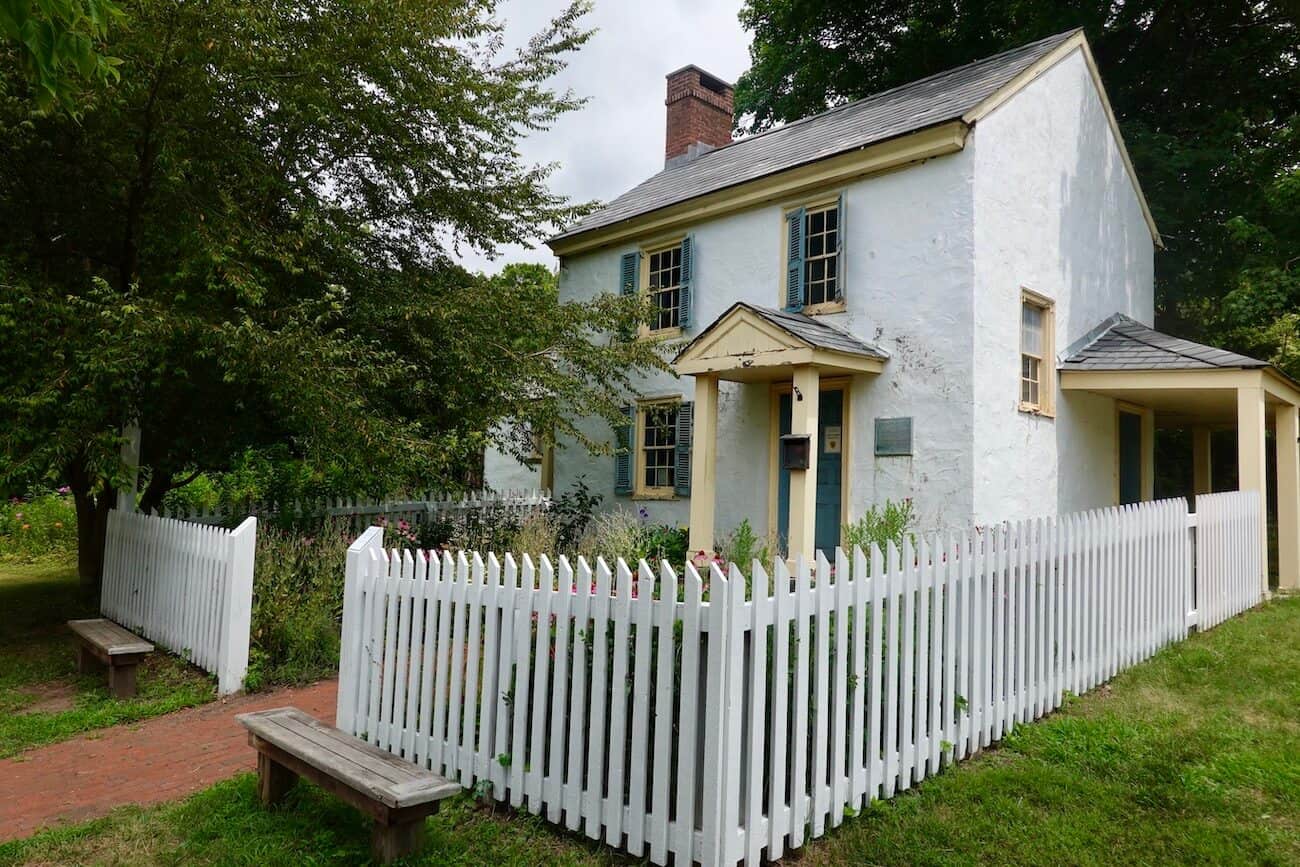

Ferry Boat Replica
Wonder how General Washington got horses and cannons across the Delaware River? This reproduction of a ferry boat, to the side of the Nelson house, will help you imagine the precariousness of hauling that cargo across the river on that stormy Christmas night.
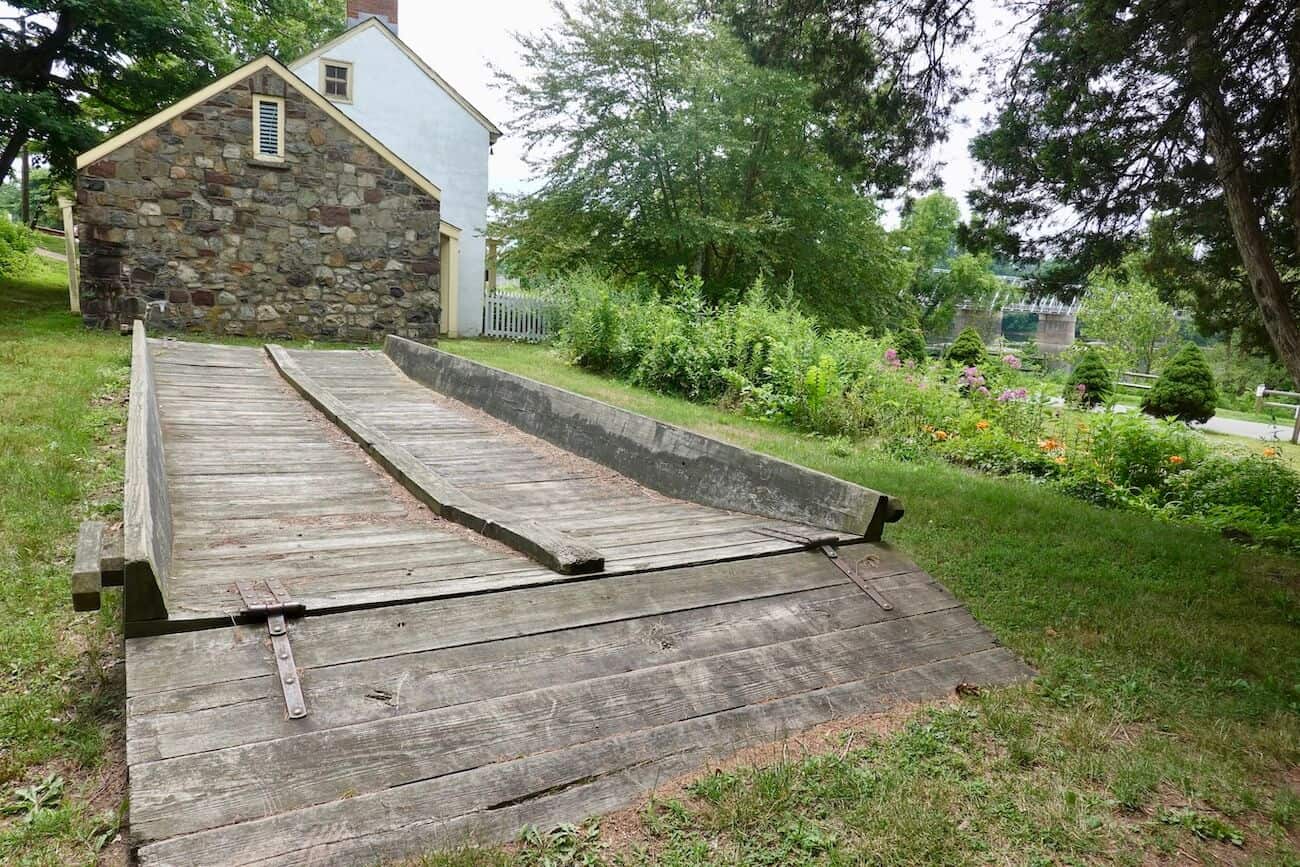
John Honeyman Fountain & Spring House
Across the canal sits this spring house. It might be better to view from afar as it’s a little tricky to reach on foot. It is named after John Honeyman, a spy who provided valuable information on the British for General Washington. He once served with the British but was sympathetic to the Patriot’s cause and wanted to help them. It is said that Washington’s men staged a ruse to fool the Hessian commander in Trenton. (The Hessians were soldiers from what is now Germany who were paid to fight for the British.)
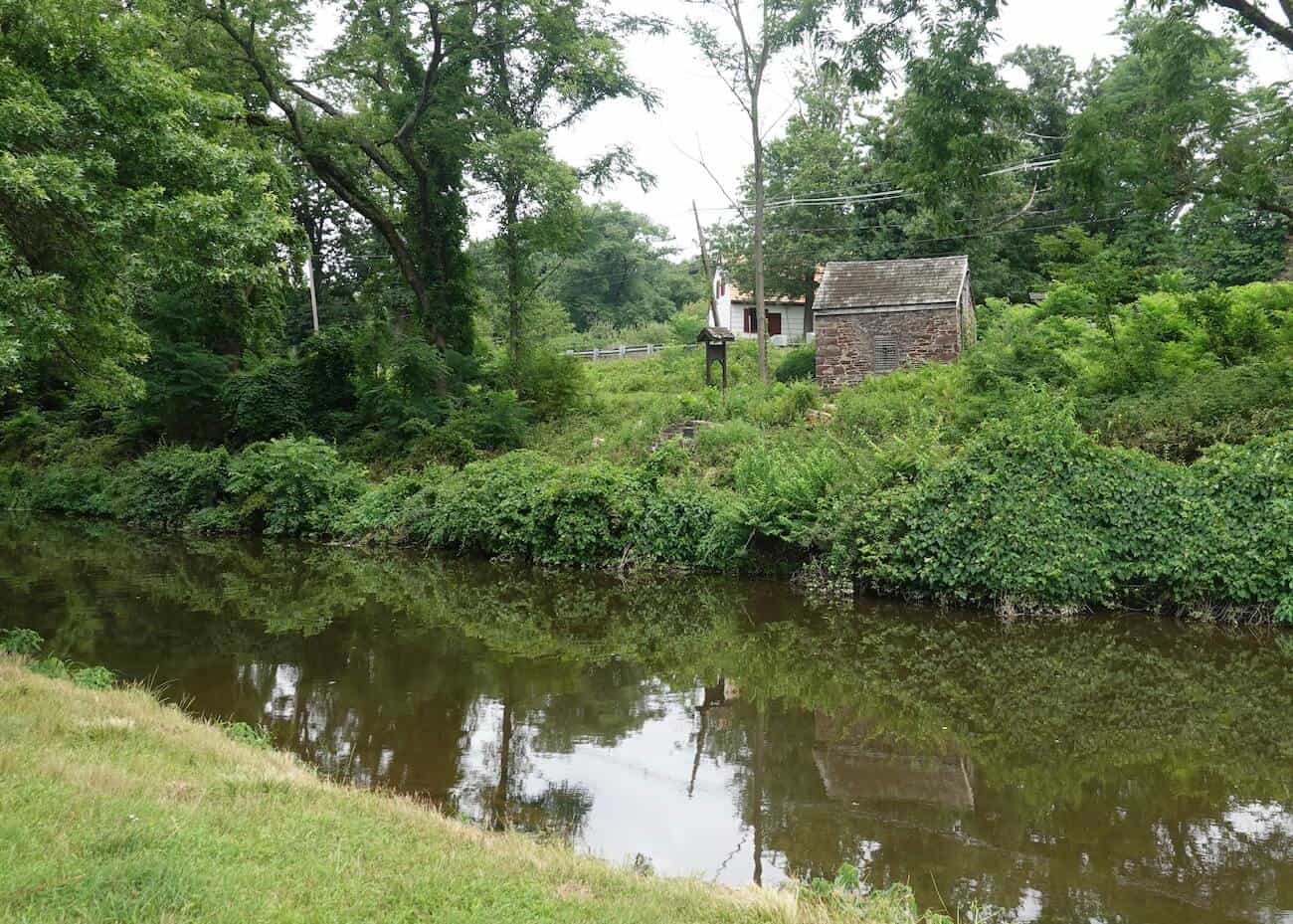
Washington’s army pretended to capture Honeyman when he came to advise Washington and then “released” him so he could return to Trenton and, ultimately, carry inaccurate information about the Continental Army’s plans back to the Hessians. Along with the stormy weather during the crossing on Christmas night and the 9-mile march south to Trenton, this trick might have played an important role in Washington’s victorious December 26 attack on the Hessian soldiers at Trenton.
Pedestrian Bridge
This bridge crosses Route 29 and connects the western parking lot to the main part of the park.
Washington’s Arboretum
At the end of the bridge is George Washington Memorial Arboretum with large, shady trees and some newer plantings: several Sweet Bay Magnolias (Magnolia Virginiana).
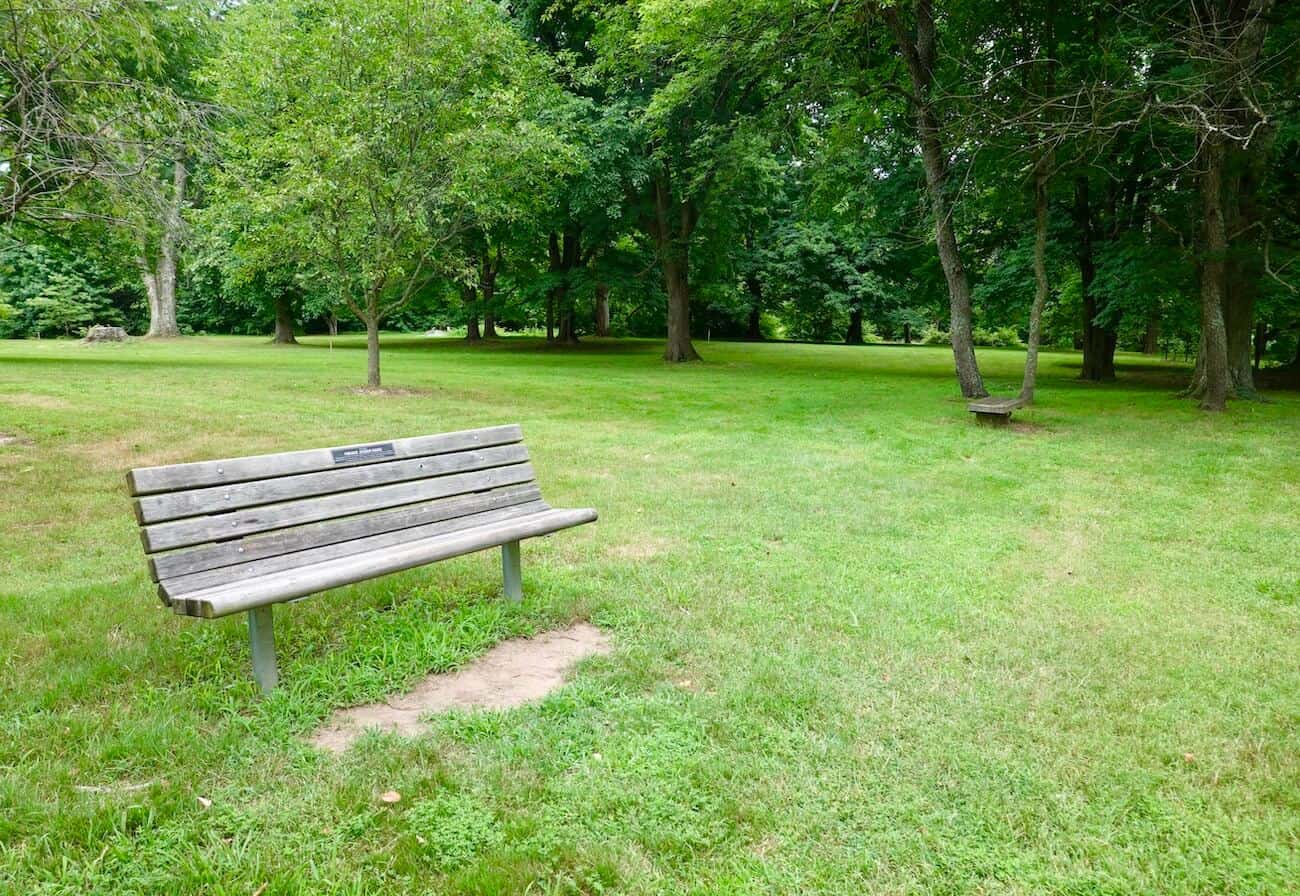
Delaware River Overlook
Stop here to have a look across the Delaware River from atop a hill. At this scenic overlook, you will observe the historic area on the Pennsylvania side (Washington Crossing Historic Park). That is where the Continental Army fled (after defeats in New York) in early December 1776 — and where they encamped for three weeks prior to the Battle of Trenton. In addition, you will be able to see the island behind which Washington hid boats and ferries from the British. Those vessels would later be used in the historic crossing on that stormy Christmas night.
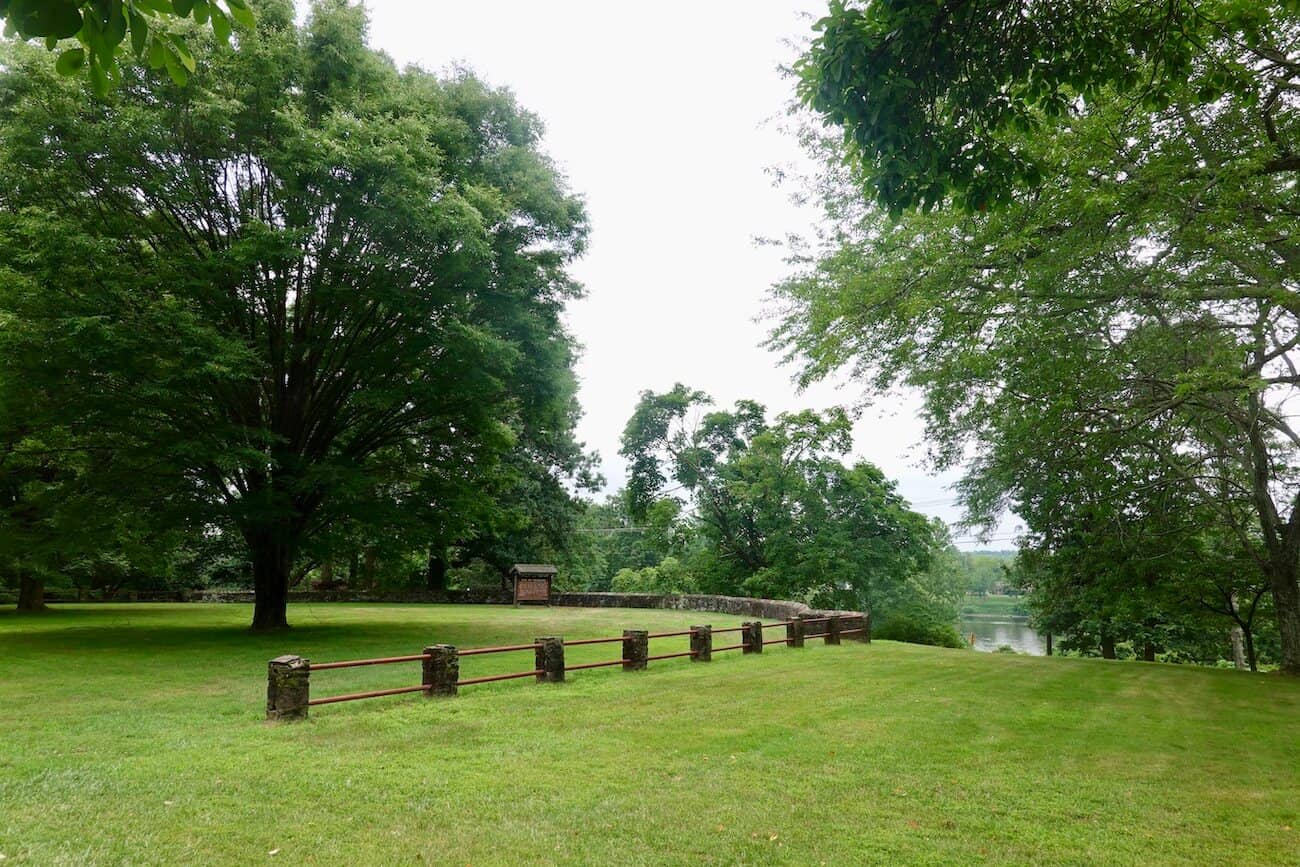
Johnson Ferry House & Garden
The only original building that stood at the time of Washington’s crossing of the Delaware River, the house sat on almost 500 acres and was owned by the Rutger Johnson family. They farmed the land and owned a tavern and ferry business. It is believed that Washington’s officers — and maybe the general himself — spent some time here on the night of the crossing waiting for his men and gear to all come across the river. (The crossing took much longer than planned due to the harsh winter Nor’easter storm that was upon them.)
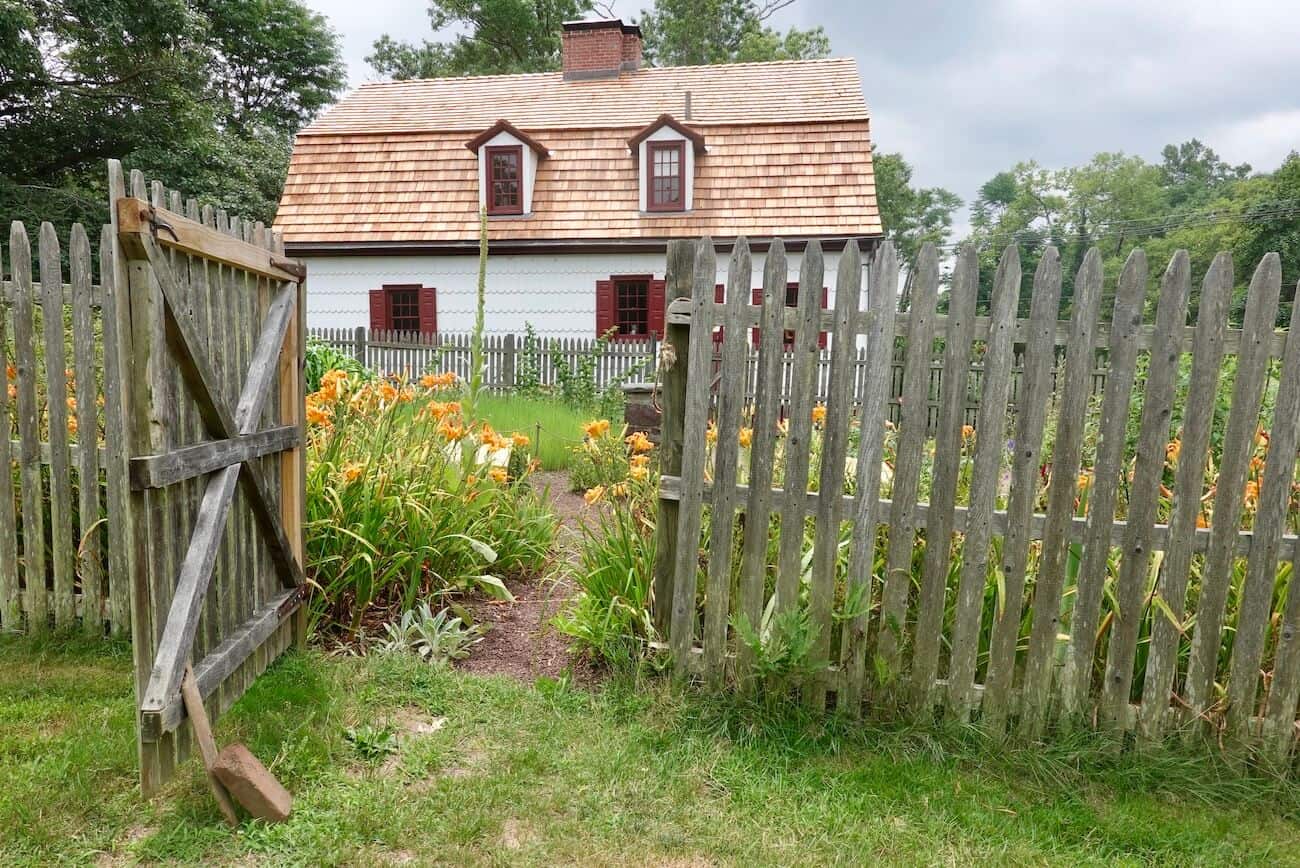
Stone Barn
Just across a paved lane (now a small parking lot) is the stone barn. This barn was built in the late 1770s. Today it’s sometimes used for demonstrations. There are restrooms here, as well.
Continental Lane
General Washington’s troops most likely marched along this lane on their way from the banks of the river to Trenton. They hauled their cannons and other equipment along with them.
Visitors’ Center & Museum
There’s an introductory film and some interesting artifacts in the museum.
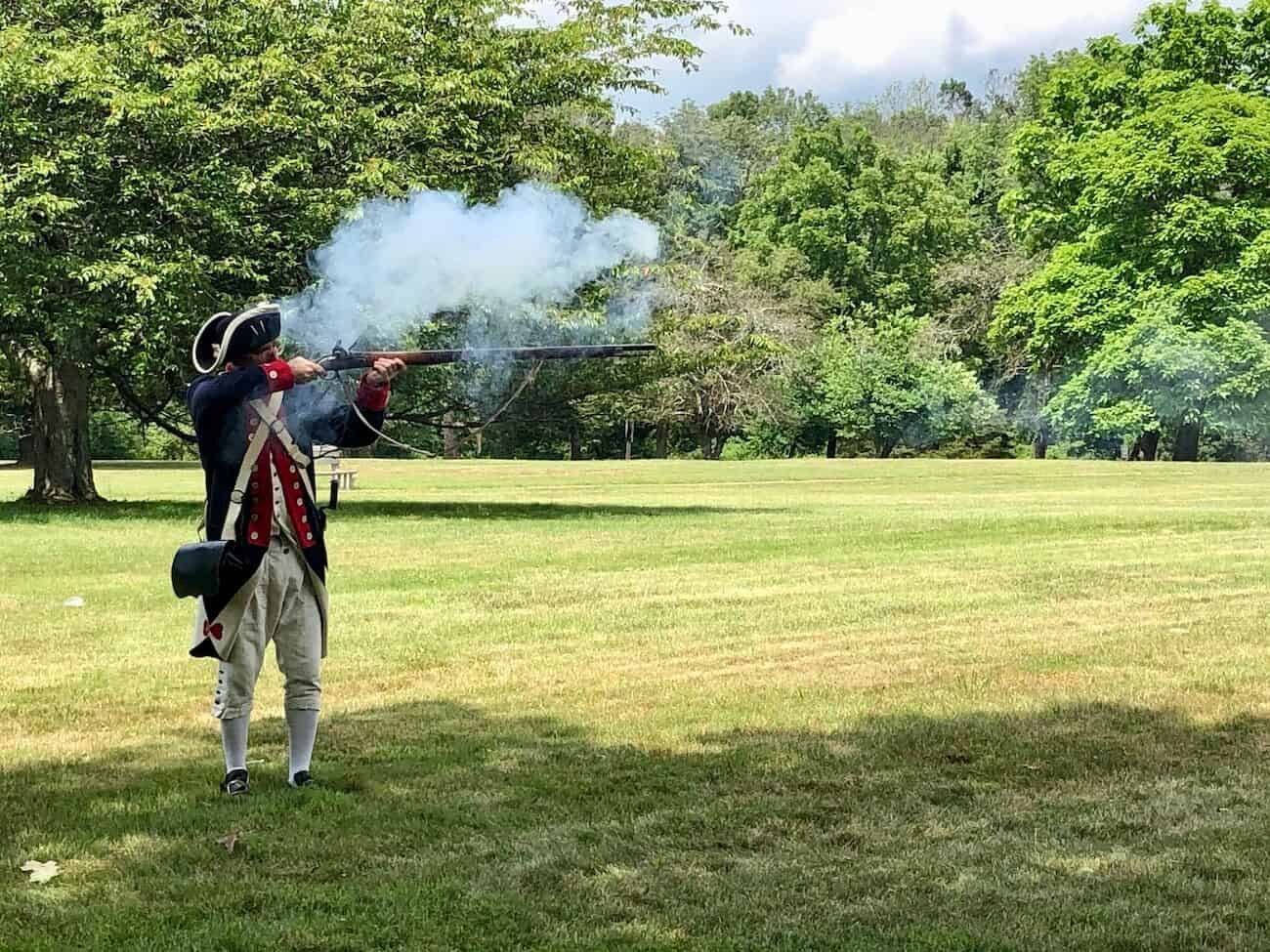
Nature Center
The nature center houses exhibits about plants and wildlife native to the area. Call or check online for updated hours of operation.
What You’ll Find at Washington’s Rock (Goat Hill Overlook)
Don’t leave the area until you head to Washington’s Rock (also known as Goat Hill Overlook). You’ll stand in the same spot as American General George Washington when he came here to view activity on the Delaware River and nearby river towns (like New Hope and Lambertville). Incidentally, this is the same place British General Charles Cornwallis later stood to view activity on the river and opposite shore.
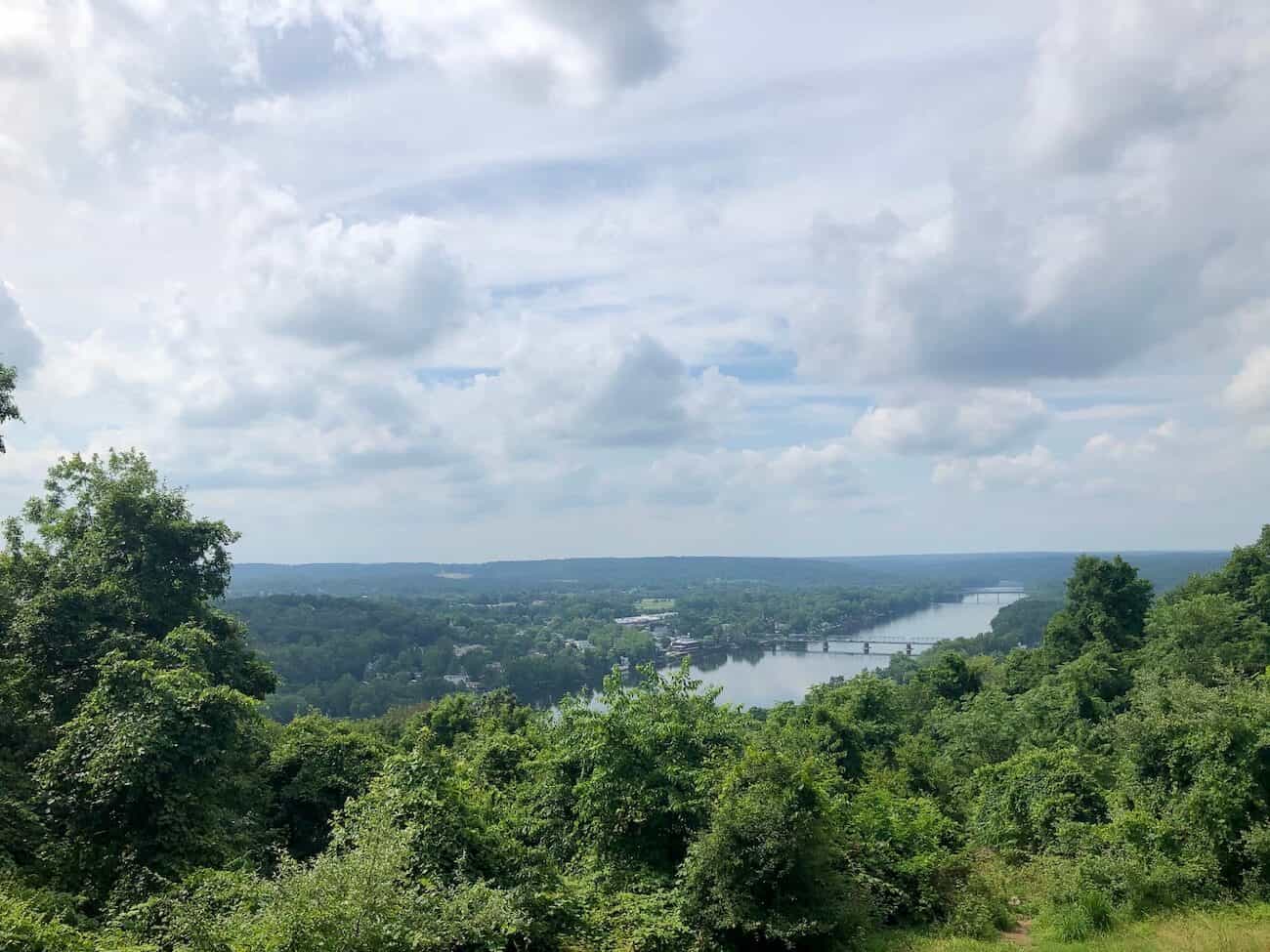
To find the overlook, enter the address into your navigation app: 21 George Washington Rd, Lambertville, NJ. You’ll be directed into the parking lot for the overlook. (When you get to the end of the road before the parking lot, take the left entry at the Y. The parking lot and trailhead are just a short distance from here.)
From the parking lot, it’s about a 10-12 minute walk along a wide trail to the lookout. There are several side trails but stay on the main one till you come to the overlook. What a view! On your trek back to the parking lot, you can explore some of the side trails. Next time we visit, we are going to bring a picnic to enjoy at the overlook.
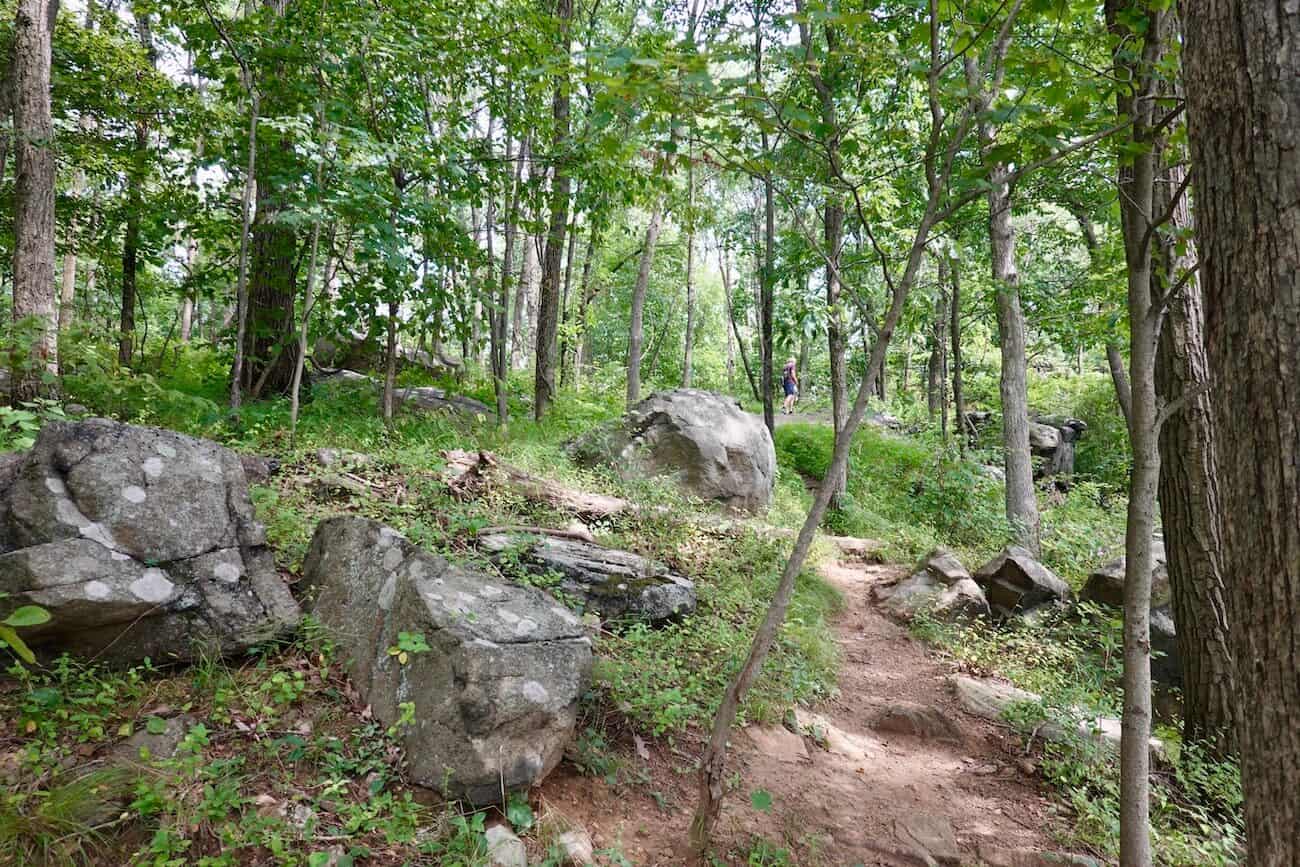
Map of Washington Crossing State Park
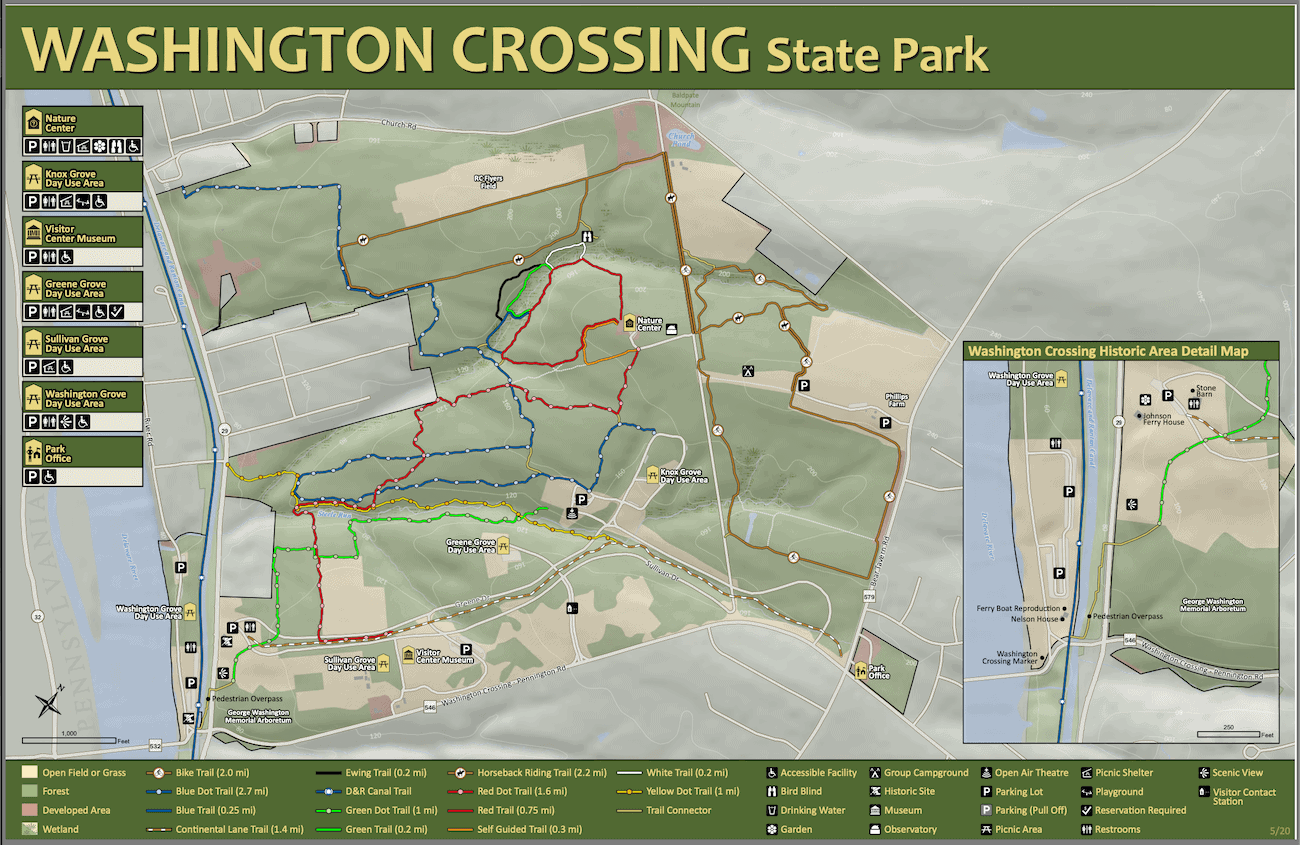
Tips for Your Visit to Washington Crossing State Park (NJ)
- Call the visitor center at 609-737-9303 to learn of special events at the park.
- Follow the park’s Facebook page to gain more information about happenings there. (This seems to be more current than the website.)
- Trails are marked with colored blazes on posts and trees. Connector trails are shown with tan lines on the map.
- Wear sunscreen, insect repellent, and a hat.
- Bring your own food and drink. Don’t forget to bring water!
- There are picnic tables near the visitors’ center and throughout the park.
- Carry in, carry out. Plan to take your trash home with you.
- Decide how you want to enjoy the park. Although you can park in the western parking lot and walk to view the main sites mentioned in this post, you could also enter the main gate of the park along Route 546, drive to the parking lot by the Johnson Ferry Farm (close to the pedestrian bridge), walk and view the sites on either side of Route 29, then continue (by foot, bike or car) to visit the other parts of the park.
- Do NOT feed or otherwise disturb any wildlife.
- Leashed pets are allowed on the park grounds.
- Camping is usually available in the park.
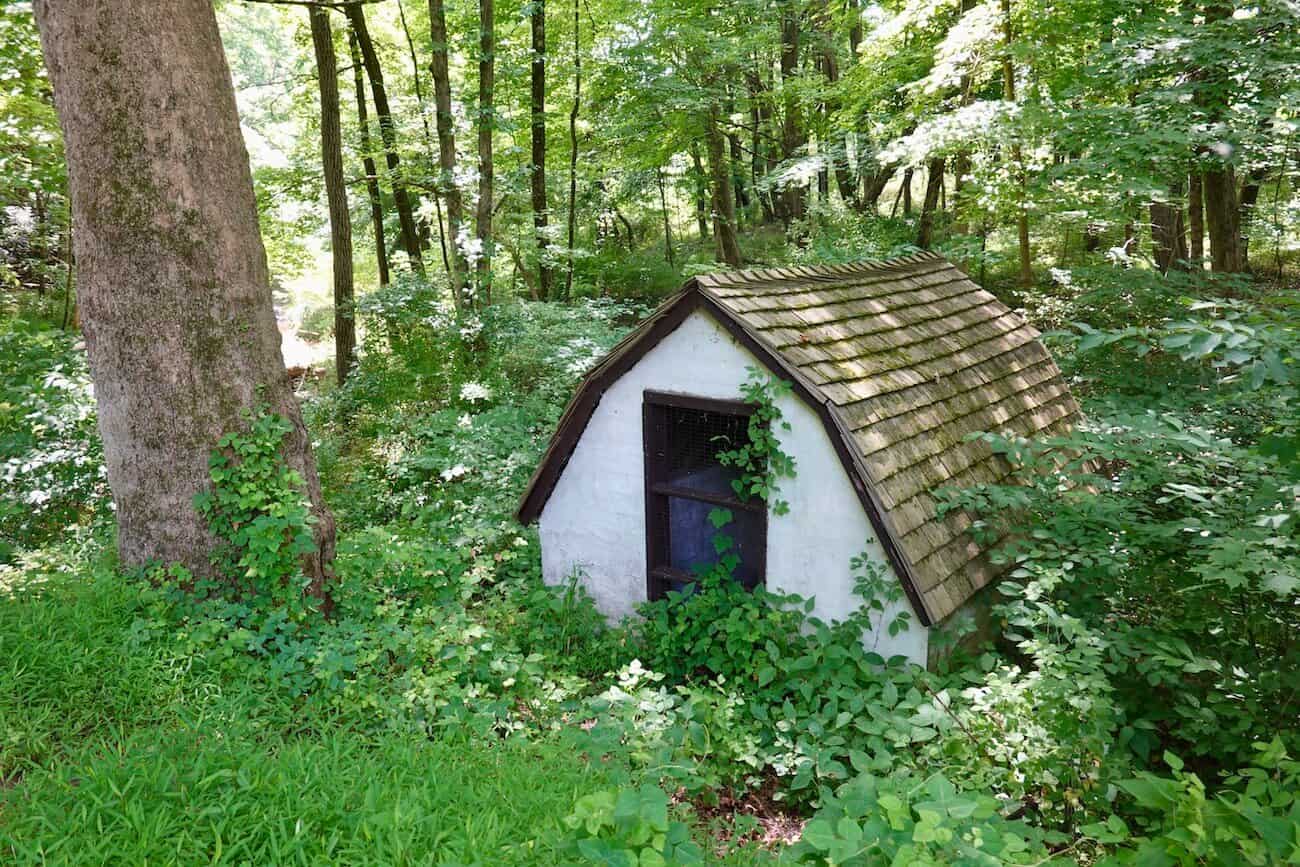
Historic Perspective on Washington’s Crossing State Park
In June 1775, George Washington became Commander-in-Chief of the Continental Army and proceeded to New England to take command of the forces facing off against the British in Boston. In March 1776, Washington’s placement of artillery at strategic locations forced the British to abandon Boston. From here, Washington decided that the most important location in the colonies to defend is the New York City region. He promptly moved his army to Long Island. The British responded by invading Long Island at the end of August 1776.
Continental Army Woes
Every battle that followed through Long Island, Manhattan, and over into New Jersey was a decisive defeat for Washington and his army. By December 1776, the Continental Army had shrunk considerably — mostly from turnover and expiring enlistments. Morale was rock bottom. The Continental Congress had not appropriated funds for winter clothing for the troops. The men hadn’t been paid for months. Many of the soldiers’ enlistments would expire on January 1, 1777. Things were looking dire.
In a strange way, it was lucky that winter was upon them. During this historical time period, few battles were fought during the winter. Washington decided to encamp his remaining army across the Delaware River in Pennsylvania. He commandeered as many boats as possible, so as to make it extremely difficult for the British to continue their pursuit. When you visit, you can see the island (near the Pennsylvania side) behind which Washington hid boats and ferries. Make no mistake about it, the Continental Army was on the run.
Planning a Surprise Attack
Washington was out of options and the revolution was likely lost. Then came field intelligence that the Hessians (soldiers fighting for the British Army) were encamped in Trenton, just across the river and roughly nine miles south. The closest British encampment was in the Princeton area. A surprise attack and defeat of the Hessians prior to the end of the year would be a much-needed boost to troop morale prior to re-enlistment time. A victory would serve as a boost to the morale of the general public, as well. To help bolster troop morale before this daring attempt, Washington had the newly published pamphlet, Common Sense by Thomas Paine, read to the men. It originated the now-famous phrase, “Give me liberty or give me death.”
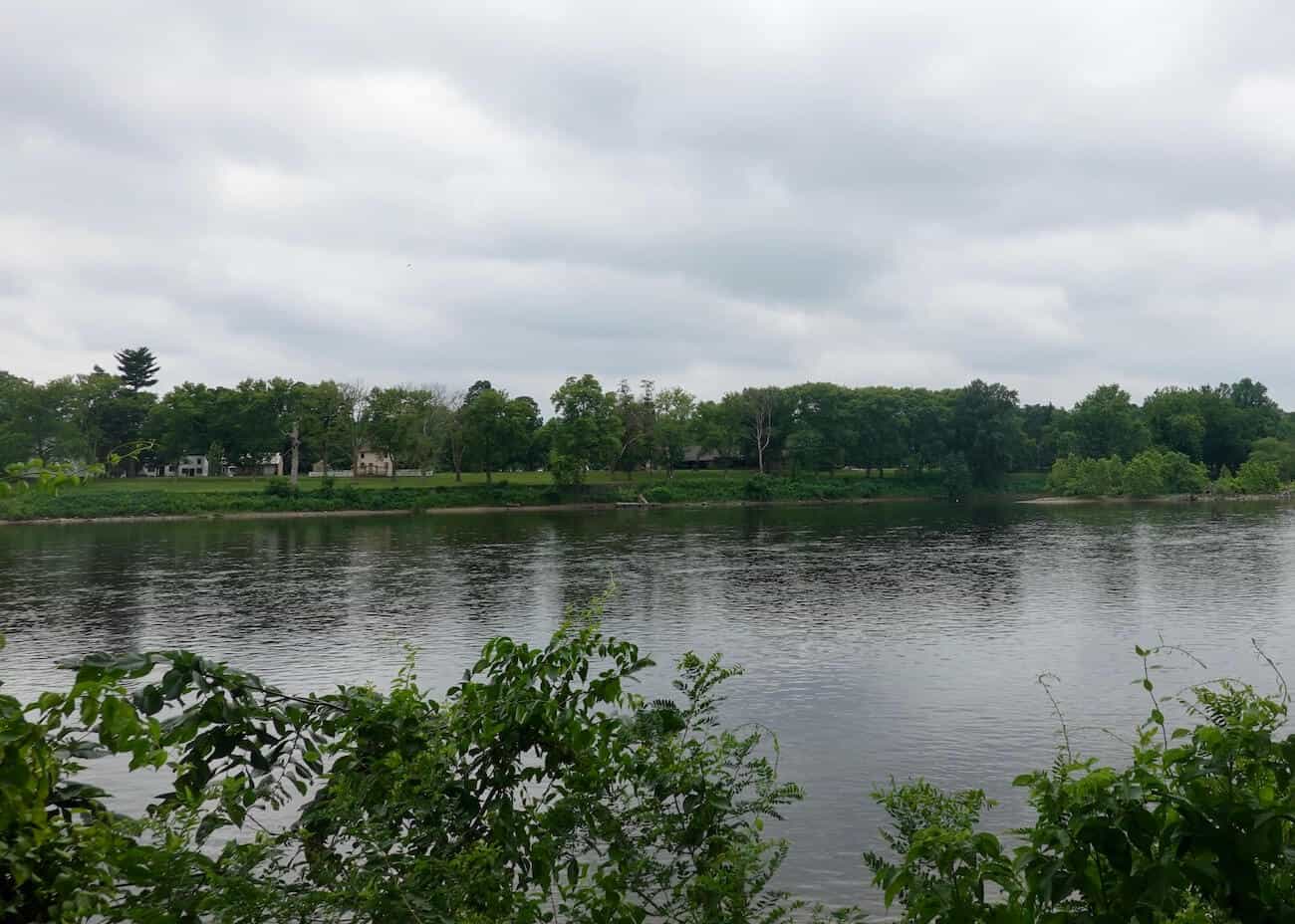
A Christmas Crossing
On Christmas evening under the direct command of Washington, about 2,400 Americans, 18 cannons, and the required number of horses crossed the Delaware River. The river was on its way to freezing over during a vicious nor-easter storm (i.e., freezing rain, sleet, snow, and high winds). Due in part to the weather, the planned four-hour crossing took almost eight hours.
Once fully landed on the New Jersey side of the Delaware River, the troops marched south to the small hamlet of Trenton where the Hessians were prepared for another day on their overseas combat assignment. (Many believe that the Hessians were recovering from a Christmas celebration that included drinking and revelry. Historians say this was not the case. They were in a “hostile” land — far from home — and battle-ready all the time.)
The inclement weather helped disguise the now-delayed attack. Washington divided his troops and launched a coordinated attack from two sides (sometimes known as a “pincer” tactic). The battle was brief due, in large part, to the overwhelming number of cannons the Americans had coupled with the element of surprise. (The wet weather also limited the effective use of muskets.)
The battle was short with the Americans decisively defeating the Hessians, taking over 900 Hessian prisoners of war. There were very light casualties on both sides. A few days later, Washington and his army went on to defeat a British contingent at Princeton before retiring his army to Morristown, New Jersey for the remainder of the winter.
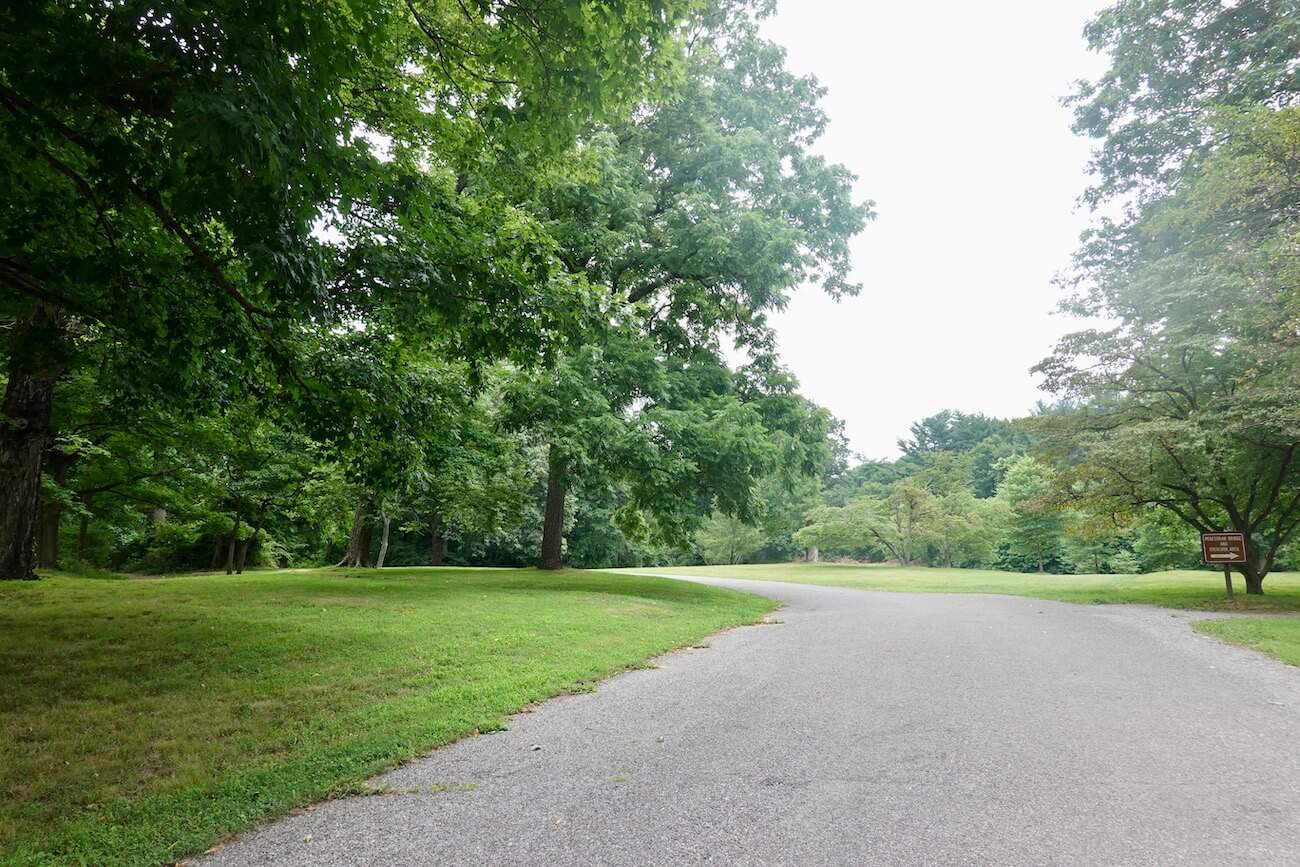
Patriot Pride
The news of the small win in Trenton and the subsequent victory at Princeton spread quickly throughout the colonies. Public morale jumped — helped by the parading of the 900 Hessian prisoners of war through Philadelphia (the largest city in North America and home of the Continental Congress). This seemed to be dramatic evidence that Washington and the Continental Army could defeat the British Empire. There was hope. Their dream of independence could possibly become reality. The rest is history.
In closing, Washington’s crossing of the Delaware River is significant and the resulting victory in the Battle of Trenton was a turning point in the Revolutionary War. As such, it is possibly the single most important event in the creation of the United States next to the Declaration of Independence.
There are annual re-enactments of the river crossing in December (plus other programming throughout the year). Check on the park’s calendar of events for details.
Nearby Attractions
If this historic period interests you, seriously consider visiting Pennsylvania’s park, Washington Crossing Historic Park, which commemorates the Continental Army’s encampment in that area for 3 weeks in December 1776 leading up to the river crossing. That park has guided tours of historic buildings and several recreation choices, too.
A short drive to Philadelphia takes you to the Museum of the American Revolution in the historic district. It’s a must-see if you’re interested in this important time period of American history. Or consider a walking tour of Philadelphia’s historic core.
Further west lies Gettysburg, the site of important Civil War battles. This Gettysburg guide will help you plan your visit there.
Final Thoughts
Having visited Washington Crossing Historic Park in Pennsylvania — and really enjoying it — my husband, Pop, and I decided to visit Washington Crossing State Park in New Jersey. The Continental Army spent three weeks resting and preparing for battle on the Pennsylvania side, but they were on the New Jersey side of the river for just a few hours.
NOTE: Washington Crossing Historic Park, across the river in Pennsylvania, has more historic sites, is more developed, and appears better maintained. There you can get detailed tours of historic buildings that help you gain a perspective on what life was like for the soldiers encamped there as well as for the local residents. This makes sense since the Continental Army spent 3 weeks there prior to crossing the river in 1776. The park in New Jersey is a great supplement to a visit to the Pennsylvania side. After visiting the Pennsylvania park, it’s easier to understand troop movements on the New Jersey side. Use this guide if you plan to visit Washington Crossing Historic Park in PA. Having said all that, my husband and I did enjoy our visit to the Washington Crossing State Park in New Jersey, but we definitely recommend the Pennsylvania park as a “starter” before visiting this one.
Despite the short time that the Continental Army gathered here, this park — and what it represents — is worth visiting. You’ll no doubt come away with a broader appreciation for what happened here over 240 years ago. Standing along the Delaware river, viewing the historic sites (including the ferry replica and the Johnson Ferry House), and listening to historians (or viewing exhibits) at the visitor center will surely enrich your understanding of this pivotal point in American history.
Nearby Attractions
There’s so much to enjoy in nearby Pennsylvania:
- Big Pocono State Park, Poconos
- Bushkill Falls, Poconos
- Covered Bridges of Bucks County
- Covered Bridges of the Lehigh Valley
- Gettysburg Visitor Guide
- Hawk Mountain Sanctuary, Lehigh Valley
- Hickory Run State Park, Poconos
- Housenick Park, Lehigh Valley
- Jacobsburg State Park, Poconos area
- Museum of the American Revolution, Philadelphia
- National Museum of Industrial History, Lehigh Valley
- Philadelphia Self-Guided Walking Tour
- Best Things to Do in Philadelphia
- Pittsburgh and Southwestern Pennsylvania Guide
- Promised Land State Park, Poconos
- Ricketts Glen State Park, Poconos
- Tyler State Park, outside Philadelphia
- Valley Forge National Historical Park, outside Philadelphia
- Washington Crossing Historic Park, Bucks County
Comments?
Please share your experiences and/or suggestions for other places to visit in the general area. Your ideas could be helpful to other travelers. Thanks! 🙂

